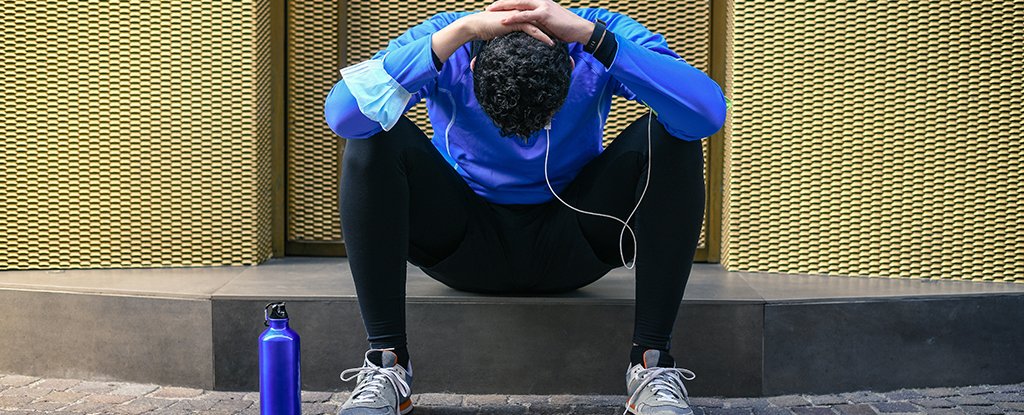Many of us exercise to feel better. While some of us experience “runners’ high” after a workout, unfortunately some of us leave the gym feeling nauseous. Although this is usually only temporary, it can still be uncomfortable.
Fortunately, there are some good explanations for why this might be happening, so if this happens to you, there’s probably no reason to be alarmed.
When we exercise, there is an increase in blood flow to the working muscles, brain, lungs, and heart.
This increase in blood flow is driven by the sympathetic part of the autonomic nervous system (which helps regulate all of our body’s involuntary responses, such as heart rate, blood pressure, and digestion). does this for widening the arteries so that they can bring more blood to these tissues.
But the sympathetic nervous system, which normally drives our “fight or flightmechanism, simultaneously narrows the blood vessels entering our gastrointestinal system (such as our stomach) during strenuous exercise by up to 80 percent.
It does this because there is a limited amount of blood in the body, and the increased demand for oxygen by some tissues can only be met by altering the amount of blood going to other tissues.
This means that the blood supply can be reduced in areas that currently do not need as much oxygen at the time. This may be the case whether or not you have eaten recently.
But let’s say you’ve recently eaten before going to the gym or going for a run. When we eat, the food stretch our stomachresulting in the release of acid and enzymes needed to digest food.
stomach muscles too be more active during digestion, causing increased oxygen demand and blood flow to the stomach and other gastrointestinal tissues. A different part of the autonomic nervous system causes increased blood flow to the gastrointestinal structures when need to be active.
The significant conflict in the body of different tissues that demand oxygen can be one of the reasons why nausea occurs during or after a workout. The body has to adapt blood flow to the tissues as demand changes.
So when we exercise, blood must go to the muscles, heart, lungs, and brain, which means blood flow is reduced in less active tissues, like the GI tract, even if it’s currently digesting our dinner. . When blood flow is reduced in this area, it activates our intestinal nerves, which subsequently causes feelings of nausea.
In addition to this, the stomach and other abdominal organs can also be compressed during exercise, which can further contribute to feelings of nausea. This is particularly a problem in trespassingAs heart rate and tissue oxygen demand increase, the body draws greater volumes of air into the lungs.
This causes the diaphragm (under the ribs) to press harder on the abdominal organs. Other muscles, such as those of the abdominal wall, also help, further compressing the abdominal organs with each breath. This can result in significant nausea and even vomiting – even on an empty stomach.
Some evidence even suggests that exercise, particularly long-distance running and other endurance events, can damage the stomach lining – probably due to the diminish in blood flow and oxygen available to the organ. This would also cause nausea.
In extreme circumstances, this can result in bleeding of the stomach liningparticularly in endurance and long-distance athletes.
when to eat
If you exercise immediately or up to an hour after eating, you are more likely to experience nausea – regardless of exercise level or training intensity.
Needed about two hours for solid foods to be broken down by the stomach and enter the small intestine, so if you experience nausea after exercising, it would be best to wait at least two hours after a meal.
What you eat before a workout can also determine if you experience nausea. Foods high in fiber, fat, and even protein are linked to higher probability nausea after a workout.
supplemental Protein, particularly whey or shakesThey are also digested more slowly. This is likely to contribute to nausea during training as the stomach tries to digest it.
Certain fats, particularly crowdedmay induce nausea differently, with animal models showing that irritate Y damage the lining of the gastrointestinal tract, which activates nerves in the lining of the stomach that connect to the vomiting center (located in the medulla oblongata) in the brain.
Consume sports drinks or other carbohydrate rich drinks (such as juices, energy drinks, and sodas), are also linked to nausea during and after a workout. This may be because these drinks are digested very slowly and stay in the stomach longer than other beverages.
If you’re someone who often experiences nausea after exercising, there are a couple of things you can do. First, change or reduce your usual training and increase the intensity slowly. This is because the longer the workout, the more blood is constantly being drawn from the stomach.
Make sure you drink enough water before and after exercising, as too little or too much can cause nausea for a variety of reasons.
In terms of eating, avoid it two hours before and choose the right food, such as high quality carbohydrates (such as bananas or sweet potatoes) and protein, as well as unsaturated fats (such as nuts). Not only will these fuel the body, but they won’t be as difficult to digest as other foods if you plan on exercising.
adam taylorProfessor and Director of the Clinical Anatomy Learning Center, University of Lancaster.
This article is republished from The conversation under a Creative Commons license. Read the Original article.
.
